
The Mary Magdalene Legacy
While searching for information on the Sicambrian Franks, we found this web site;
"When Solomon died, the ten tribes separated. Later in 721 B.C they went into Assyria
(Iraq) and Media (Iran), except for the tribe of Dan which went into Ethiopia, Danmark,
Scotland, and Ireland. (The Roman Emperor who defeated the Bar Kochba rebellion
1n 132-136A.D, also tried to conquer the Jews in Scotland.) The link below is a review
of the research from an actual bloodline descendent of Jesus. The genealogy continues from the records of the
Demarest Museum in Demarest, New Jersey, USA." This site confirms what we have been
saying for years. The origional Knights Templar were descendents of the royal blood
line of Jesus and his family.
So now we have further confirmation that the
Merovingian bloodline is real and continues. check it out..
The History of the Des Marets Family.
Then compair that Demarest list with this one...
The Merovingian Kings.
and see Pope Gregory -
The change he made in 604 that condemed Mary Magdalene as a harlet.
On our Intro page we mentioned Graham Hancock's Book, Fingerprints of the Gods. His work introduced us to a white or red haired 'bearded stranger' who is dressed in long flowing robes, had blue eyes and was Caucasian. He walked with a staff and addressed the natives with love, calling them his sons and daughters. He walked the land and worked miracles. He healed the sick by touch. This God's name was Viracochas .
In the myths of many cultures you find the appearance of a Teacher God who brings the arts of civilization to humankind. The presumption is that humans were at first rather primitive and then by the grace of the gods were given the gifts of fire, domestication of animals, agriculture, brewing, architecture, speech, writing, music, makeup, and government.
The Indians of the Americas credited the pale-skinned blue-eyed god Quetzalcoatl and his companion Viracochas with having brought the arts of civilization to them long before the conquering and colonizing 15th century Europeans arrived to destroy so much of it in their own misguided religious fervor. Quetzalcoatl appeared to the earliest known cultures in South America, the Inca and the Maya. But he appeared in other cultures too and his name was different depending on the area and language spoken. The genology associated with this God seems to be associated with all of the biblical heroes begining with Adam and including King Solomon, all the way to Jesus. They all had white or red hair, blue eyes and were Caucasian.
Often, these Teacher Gods arrived, mentored the humans for a while, and then left, promising to return. As far as we know, none of them ever have. Yet.
This link has articles on all the gods and their respective cultures. God Checker
Although situated in North Africa, Egypt had been settled by three White groupings prior to 3500 BC, namely Old European Mediterranean types, Proto-Nordics and Nordic Indo-Europeans, with the latter group penetrating the territory as part of the great wave of Indo-European invasions which took place from 5600 BC onwards. As discussed on Forbidden Knowledge Ham went to Egypt. Nimrod, also known as Namer was a king in the pre-dynastic area of Egypt before 3500 BC. This comes from TAMARISK VS DATE PALM, a Sumerian text. "In former days, in far-off years when... The heavens were grieved and the earth groaned at evening time, the gods appeared o mankind, they became appeased and granted them abundance. "To guide the land and establish the peoples they appointed a king. ... To rule the black-headed, the many peoples,
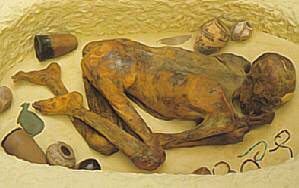 Entering Egypt at the time of the great
Indo-European migrations from the Black Sea Basin circa 5600 BC, Nordic peoples such as "Ginger"
settled the Nile River Valley and laid the basis for what was, by 3000 BC, to become the first
Egyptian Dynasty.
Entering Egypt at the time of the great
Indo-European migrations from the Black Sea Basin circa 5600 BC, Nordic peoples such as "Ginger"
settled the Nile River Valley and laid the basis for what was, by 3000 BC, to become the first
Egyptian Dynasty.
Living in typical Neolithic settlements, this period of history is called the pre-dynastic period and is formally considered to have come to an end in 3100 BC. see Chapter 8: Egypt: Nordic Desert
There are many things written about Biblical patriarchs being born miraculously, and with white hair, what does this mean? Outside the Bible we find more descriptions.
The Akbar-Nama of Abu-el-Fazl; translated from Farsi
(ancient Persian) by H. Beveridge,
New Delhi: It is well known that Adam was born miraculously with curling white hair, and fair,
wheaten-colored skin. He was the world's first great Uriah (teacher) Why would they mention
that Adam had white hair? Noah was also born with white hair, and Seth and Ham, and Sarah
(Sarasvati to Hindus). If Jesus were fair complexioned, this would appear to be an inherited family
trait. Could it be a genetic trait; or a genetic error, Looking at the mummies of Egypt on the
Ethiopian page, who were Jesus' grandparents, they look more 'European'. In The British Isles,
they were known as Teselphas-Essenes who bore the title Gew-ISSAE (from the Celtic land of
Gewissae). It is the writers theory that the family of Jesus had their roots and family ties in the
Himalayas, where they were descended from the Tocharians (link below) that once dominated
that area.
Rev. Lionel S. Lewis in his book, St. Joseph of Aramathea at Glastonbury states:The pedigree of Jesus' immediate family is startling. Anna, Jesus' grandmother, was mother not only of Mary, but later also of Penardin (a Cornish name) who married King Lear. Regarding Mother Mary's husband Joseph, he was descended from the matriarchal family of Obali (Croazia,Celt-Irish) and was chosen to be the guardian of Mary and Jesus. The family was also directly linked with Helen of Troy. For further reading, please obtain The Holy Land of Scotland by Barry Dunford
Now it makes more sense that the pictures of Jesus on Buddhist caves painted 2,000
years ago in India would also look like this version of Jesus.
The Old Testament actually
supports a more 'Euro-Nordic' Jesus: 'Check the Ethiopian mummy pages to see the Egyptian
blond pharaoh-mummies exactly as described in the Talmud and Bible.
The Encyclopedia Britannica says, "The Nubians are supposed by some authorities to agree with the ancient Egyptians more closely than the Copts, usually deemed their representatives." According to Dr. Pritchard, it is probable that the Barabra may be an offshoot from the original stock that first peopled Egypt and Nubia. It was the Old Race of the higher civilization that ruled Egypt in the pre-dynastic ages. It was from this nation went forth the colonies that spread civilization. This old race of the Upper Nile, the Agu or Anu of the ancient traditions, spread their arts from Egypt to the Ægean, from Sicily to Italy and Spain. Mosso Angelo says that the characteristic decorations on the pottery of the Mediterranean race of prehistoric times is identical with that of pre-dynastic Egypt . Reisner in 1899 examined 1200 tombs in the Nile valley. He found the remains of a distinct race who buried their dead with legs doubled up against abdomen and thorax. This was an old Ethiopian form of burial, which preceeded embalming and may be traced through ancient Cushite lands. This article came from.. Sacred Texts
There is evidence both from the mummies and Chinese writings that some of them had blond or red hair and blue eyes, characteristics also found in present-day Afghanistan, Pakistan, Tajikistan and Central Asia, due to the populations' high genetic diversity. (The high frequency of blonds in Europe today is due to selection, with Finns having the highest; though in ancient times, it seems the Thracians were commonly regarded as the original blonde race.) Read about the DNA of the Tocharians of Asia.
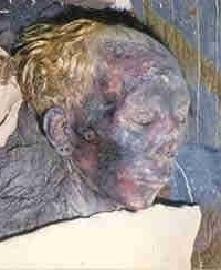 We represented the origional Egyptians as being blonde, red or white haired and blue eyes on
Forbidden Knowledge.
Black Supremency groups have tried to portray the Egyptians as black. All these links verify they
were not. This is just one more link to the Sumerians or 'Gods' we have proposed that were in Egypt..
White Egypt. Yuya-(Joseph II)
Biblical Joseph; Egyptian Prime Minister (vizer) during 1500 BC. Father of Tiy. Yuya's blonde hair and
Caucasian facial struture have been well preserved by the embalming process.
We represented the origional Egyptians as being blonde, red or white haired and blue eyes on
Forbidden Knowledge.
Black Supremency groups have tried to portray the Egyptians as black. All these links verify they
were not. This is just one more link to the Sumerians or 'Gods' we have proposed that were in Egypt..
White Egypt. Yuya-(Joseph II)
Biblical Joseph; Egyptian Prime Minister (vizer) during 1500 BC. Father of Tiy. Yuya's blonde hair and
Caucasian facial struture have been well preserved by the embalming process.
In Genesis 14, Abraham is given the pseudonym of Shem-eber king of Zeboiim (Memphis). Shemeber is translated as "Illustrious." However, it is also a compound name comprised of Shem (Sabium) and Eber (Hammurabi). These two ancestors were not only kings, but also masters of the sciences, law and philosophy . Abraham was placed in their company, not only with respect to wisdom, but also in kingship. Zeboiim, that is Memphis, (Avaris) was the ancient seat of kingship and wisdom in Egypt. (Ref: Living in Truth: Archaeology and the Patriarchs by Charles N. Pope)
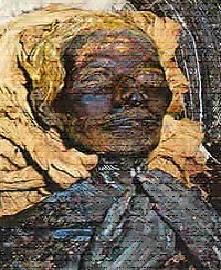 Queen Tiy (Taia,Tyre)
Father was Yuya. Mother Thuya, Mother and wife of Akhenaten (Pharaoh
Priestess of the God Amun Amenhotep III who was the father of Aye whom replaced
Tutankhamun after his death) The myths and legends of Greece, India and South America
describe the rule of Osiris and Isis. 'The Mighty Osiris and Isis walked into the Egyptian
Valley out of nowhere and assumed command. 'They were taller and more imposing than the
men of the time, with long blond hair, marblelike white skin and remarkable powers that
enabled them to perform miracles. see
Red Haired Mummies.
and NORDIC NOBILITY IN ANCIENT EGYPT
The Egyptian records show that the Minoans from Crete had helped to fight the Semitic
Hyksos invaders - further evidence of the close links between the Egyptians and the
Old European civilization.
Queen Tiy (Taia,Tyre)
Father was Yuya. Mother Thuya, Mother and wife of Akhenaten (Pharaoh
Priestess of the God Amun Amenhotep III who was the father of Aye whom replaced
Tutankhamun after his death) The myths and legends of Greece, India and South America
describe the rule of Osiris and Isis. 'The Mighty Osiris and Isis walked into the Egyptian
Valley out of nowhere and assumed command. 'They were taller and more imposing than the
men of the time, with long blond hair, marblelike white skin and remarkable powers that
enabled them to perform miracles. see
Red Haired Mummies.
and NORDIC NOBILITY IN ANCIENT EGYPT
The Egyptian records show that the Minoans from Crete had helped to fight the Semitic
Hyksos invaders - further evidence of the close links between the Egyptians and the
Old European civilization.
The genology continues: This list is only from Clovis I (481) - to Theodore IV (737).
We compaired that list with the list compiled by Laurence Gardner, p335-340 The Magdalene Legacy,
and it is exactly the same. Gardners list begins with King David stops at Galahad apx 603 A.D.
This list does list Jesus' daughter Tamar, his first son Jesus II and second son Joseph.
Joseph's descendents are the first of the Fisher Kings. They married far distant relatives
of Lazerus, Mary Magdalene's brother beginning in 170 A.D.
Jesus' sons both had children but Jesus II's (37 A.D.) descendents after Alain are not known.
The Sicambrian Franks, beginning with Dogobert I and the Fisher Kings then married. The dates
however do not match up.
Then we compaired that with this list -
Merovingian list 1
and Merovingian list 2and
Merovingian list 3
from Holy Blood Holy Grail. Suzanne seems to be a direct descendent of Baldwin (Baudoin) who
was instrumental in the formation of the Knights Templar.
Knights Descendent list from 1011 A.D.
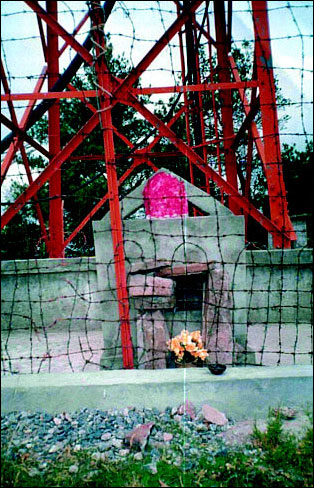 The author is Suzanne Olsson,
who is a recognized scholar on the subject. She became interested in researching the legend
of Jesus in India after a local museum in Demarest,(town established by her family)
New Jersey linked her family genealogy to Mary Magdalene. Olsson spent several years on
the Old Silk Road following the trail that Jesus and his mother Mary (Rosa Bal) are said
to have taken on their journeys to India. The scriptures indeed indicate that Mother Mary
and Thomas, Jesus' twin brother went to India to escape proscution.
The author is Suzanne Olsson,
who is a recognized scholar on the subject. She became interested in researching the legend
of Jesus in India after a local museum in Demarest,(town established by her family)
New Jersey linked her family genealogy to Mary Magdalene. Olsson spent several years on
the Old Silk Road following the trail that Jesus and his mother Mary (Rosa Bal) are said
to have taken on their journeys to India. The scriptures indeed indicate that Mother Mary
and Thomas, Jesus' twin brother went to India to escape proscution.Suzanne acquired international notoriety when she became the first and only person in history given permission to obtain DNA from the graves for a comparison, and confirmation of their identities. At the eleventh hour, the project was halted by militancy.
A further article linking Suzanne with Mary, mother of Jesus who is said to be buried in India. see Grave in India/Pakistan, From article FT (forteantimes) 183 May 2004. This link also provides recommended reading from other researchers sites who agree with Suzanne and have been saying the same thing for years.
From the above site; Joseph (2nd Joseph of Arimathea or the 2nd son of Jesus and Mary Magdalene): King Arviagus of Silurian granted this son land in Glastonbury, at a time when Roman imperialism was on the rise and this led to many unions between the Druids, the Celts, and the Messianic line. Colchester was then called Camulod (Camulodunum) and is presumed to be the possible Camelot of later legends. Research indicates the British Isles have always been home to Jesus' grandparents and parents, and they owned extensive properties in Ireland, Scotland, and Wales, and well into Egypt and the Holy Land. This son was well known as a wealthy metal trader in the tradition of his ancestors, like Old Testament Tubal-cain and Hiram Abiff. History records the stoning to death (figurative? Or literal?) of this son in AD 62 in Glastonbury, where he is buried. This evidence is presented on The Marriage of Jesus and Mary. The children are discussed on a connecting page. Mary Magdalene had red hair.
Dagobert-I ~ Nanthild, King of Austrasia, King of the Franks By this time, about 674, a council of leading bishops had extended its authority while at the same time reducing the powers of taxation and administration by the royal house, rendering it weaker and less and less effective. Dagobert II was only five years old when his father, King Sigebert-II (Lothar) died. Dagobert was kidnapped and hidden in Ireland, where he managed to get an education while at Slane Monastery, near Dublin. His mother was told he’d died. At age 15 he married the Celtic Princess Matilde, but she died soon after and he decided to return to France.
Meanwhile Grimoald, who had kidnapped Dagobert, put his own son on the throne. Dagobert married a niece of the Visigoth King. Grimoald’s plot was thwarted for a while, and after 20 years absence, Dagobert was reinstated as rightful king. Soon after he was lanced to death and the Church reinstated the Grimoald line. This began a change in succession of royalty. It was no longer a blood right, but something that could be appointed and coronated by the Church (circa 761 Pepin the Short) in league with the Pope was the first coronated king, deposing Childeric, the next rightful successor.
Pepin began the line of Kings known as the Carolingians). 19. Clovis-II ~ Batilde 20. Theuderic-III King of Neustria & Burgundy & Austrasia In the 730’s Islam (the Moors) were forced to retreat to Narbonne, in the South of France.
Pepin the Short couldn’t win against them without help. He sought help from the Jews. They agreed to help but only if a Hebrew King, a recognized descendent of the Royal House of David was restored and a Jewish kingdom was again established in the territory of Burgundy. Pepin agreed and the Jews ousted the Moors, and then established the kingdom of Septimania (The Midi) with Narbonne as its capitol. Theuderic had been ousted from power. He was married to Pepin the Short’s sister, Alda. Their son, Count Guilhelm de Toulouse, became King of Septimania in 768. see the site above (The History of the Des Marets.)
The foundation of the Knights Templar
Today the Order in the U.S. insists that all members be Christians. But orders in the European countries remain much as they were almost 1000 years ago.
 Godfrey de Bouillons was also known as the Duke of Lower Lorraine.
His mother was the famous St. Ida, and his brother was Count Eustace-III of
Boulogne. Godfrey-I became the designated King of Jerusalem after the First
Crusade. He chose not to use the title ‘king’ and was known instead as ‘Guardian of
the Sacred Sepulcher.’ Of the eight crusades which persisted until 1025, only this first
was successful, but even this was marred by the excess of a few irresponsible troops.
Godfrey died in 1100, soon after his Jerusalem triumph, and was succeeded by his
younger brother, Baldwin of Bologne. After 18 years Baldwin was followed (in 1011)
by his cousin, Baldwin du Bourg, in the same year the Knights Templar was founded.
Godfrey de Bouillons was also known as the Duke of Lower Lorraine.
His mother was the famous St. Ida, and his brother was Count Eustace-III of
Boulogne. Godfrey-I became the designated King of Jerusalem after the First
Crusade. He chose not to use the title ‘king’ and was known instead as ‘Guardian of
the Sacred Sepulcher.’ Of the eight crusades which persisted until 1025, only this first
was successful, but even this was marred by the excess of a few irresponsible troops.
Godfrey died in 1100, soon after his Jerusalem triumph, and was succeeded by his
younger brother, Baldwin of Bologne. After 18 years Baldwin was followed (in 1011)
by his cousin, Baldwin du Bourg, in the same year the Knights Templar was founded.
They were said to have begun with a small group of nine French Knights vowing to protect the Holy Land. They were installed in Baldwin’s palace at the site of Solomon’s Temple. When Baldwin moved to the Tower of David, the Temple quarters were given over entirely to the Templars. They were relatives and members of the ruling families of the time. Deep beneath the Temple were the stables of King Solomon, untouched since ancient times and said to be large enough to hold 2,000 horses. It was also rumored to contain the Ark of the Covenant and the original Ten Commandments. However, what the Templars most wanted were another set of Tablets said to be written by God for Moses, these were said to be engraved with the ‘Table of Testimonies’-The Cosmic Equation, the divine laws of numbers, measures, and weights.
The mystical art of reading the inscriptions was the cryptic system devised called the Cabbala (Kaballah). The Ark itself, plated in gold, was actually thought to be an electrical conductor. One of these duplicates may have been in Jerusalem, the other at Axum, Ethiopia. The origional Ark is believed to be in Egypt under the paw of the Sphinx.
Huge amounts of gold and wealth were also removed by the Templars, as revealed in the Copper Scrolls discovered in 1956. It is important to point out here that the Crusades were not just wantonly begun as mindless aggression against Muslims. The Muslims had been ruthlessly attacking and invading surrounding lands, leaving death and destruction everywhere. It was the few survivors who had cried out for help that led to the crusades. Realizing if they didn’t protect Jerusalem, their ancestral home, then their heritage here too would be destroyed; the first crusades were the very first attempt of the Hebrews and Christians to work together to protect what was always theirs! King David even had the original deed to these lands..
The Templars moved everything to the Champagne Court at Troyes to work and study. St. Bernard became the official head of the Templars, which became an officially recognized religious order. They were granted vast land holdings that criss-crossed the global map. Within a decade they were probably the most revered and infuential body the world has ever known. France was the first to benefit, and this began the era of great Cathedrals like Notre Dame built with this new ‘sacred geometry.’ They had also uncovered many ancient and unadulterated scrolls, which revealed that the Church had altered scriptures. This led to their persecution by the Dominicans and the savage 14th century Inquisition. It was the point in history that the last vestiges of free thinking disappeared from the Catholic Church, and rigid dogma set in. The relatives continued below were also members of the Knights Templar and Heralds of the Golden Fleece...
 According to Guillaume de Tyre the Order was founded
by a vassal of the Count of Champagne, a certain Hugh de Payen, acting
in collaboration with André de Montbard, the uncle of Bernard of
Clairvaux. In 1118, the two knights along with seven companions
presented themselves to the younger brother of Godfroi de Bouillon who
had accepted the title of King Baudoin I of Jerusalem. They announced to
the monarch that it was their intention to found an order of warrior
monks so that 'as far as their strength permitted, they should keep the
roads and highways safe . . . with a special regard for the protection
of pilgrims.' The new order took vows of personal poverty and chastity
and swore to hold all their property in common. The king granted them
quarters which included the stables of what was believed to be the
Temple of Solomon. The Patriarch of Jerusalem granted the new order of
knights the right to wear the double barred Cross of Lorraine as their
insignia. The original nine knights are generally believed to have been:
According to Guillaume de Tyre the Order was founded
by a vassal of the Count of Champagne, a certain Hugh de Payen, acting
in collaboration with André de Montbard, the uncle of Bernard of
Clairvaux. In 1118, the two knights along with seven companions
presented themselves to the younger brother of Godfroi de Bouillon who
had accepted the title of King Baudoin I of Jerusalem. They announced to
the monarch that it was their intention to found an order of warrior
monks so that 'as far as their strength permitted, they should keep the
roads and highways safe . . . with a special regard for the protection
of pilgrims.' The new order took vows of personal poverty and chastity
and swore to hold all their property in common. The king granted them
quarters which included the stables of what was believed to be the
Temple of Solomon. The Patriarch of Jerusalem granted the new order of
knights the right to wear the double barred Cross of Lorraine as their
insignia. The original nine knights are generally believed to have been:
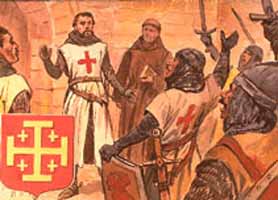 Hugh de Payen, a vassal of Hugh de Champagne and a
relative by marriage to the St Clairs of Roslin.
Hugh de Payen, a vassal of Hugh de Champagne and a
relative by marriage to the St Clairs of Roslin.André de Montbard, the uncle of Bernard of Clairvaux and another vassal of Hugh de Champagne.
Geoffroi de St Omer, a son of Hugh de St Omer.
Payen de Montdidier, a relative of the ruling family of Flanders.
Achambaud de St-Amand, another relative of the ruling house of Flanders. Geoffroi Bisol, Gondemare, Rosal, Godfroi.
Gondemar and Rosal were Cistercian monks who were now just transferring their allegiance. Many would simply see this transfer as one that took place between the monastic and the military arm of the same order, for the Cistercians and the Knights Templar were so closely linked by ties of blood, patronage and shared objectives that many Templar scholars believe that they were two arms from the same body.
The position of Hugh de Champagne in this whole affair is curious and confusing in the extreme. There is a letter to him from the Bishop of Chartres dated 1114, congratulating him on his intention to join la Milice du Christ, which is another name for the Knights Templar. He certainly took up a form of lay associate membership of the order in 1124 and thereby created a bizarre anomaly in feudal terms, for by joining the Order and swearing obedience to its Grand Master Hugh de Payen he came under the direct control of a man who in the normal social order of things was his own vassal. There is a secret Templar archive in the principality of Seborga in northern Italy which has recently been discovered containing documents that demand further study. It is claimed that St Bernard of Clairvaux founded a monastery there in 1113, to protect a 'great secret'.
This monastery under the direction of its abbot, Edouard, contained two monks who had joined the order with Bernard, two knights who took the names of Gondemar and Rosal on their profession as monks. One document claims that in February 1117 Bernard came to this monastery released Gondemar and Rosal from their vows and then blessed these two monks and their seven companions, prior to their departure to Jerusalem. This departure was not immediate and did not take place until November 1118. The seven companions of the two ex-Cistercians are listed as follows: André de Montbard, Count Hugh I de Champagne, Hugh de Payen, Payen de Montdidier, Geoffroi de Sainte-Omer, Archambaud de St Amand and Geoffroi Bisol. The document records that St Bernard nominated Hugh de Payen as the first grand master of the Poor Militia of Christ and that Hugh de Payen was consecrated in this position by the Abbot Edouard of Seborga.
Whether or not Hugh de Champagne was directly involved in the actual founding of the Knights Templar is a decision we will leave to scholars of far greater wisdom than ourselves. Whatever the truth may prove to be, two things are certain. Firstly the count of Champagne was at the very least a prime mover behind the scenes even if he is not to be numbered among the original nine founding knights. Secondly, all those involved in both founding and promoting the Order were linked by a complex web of direct family relationships.
The main reason given for the founding of the Order, to protect the pilgrim routes, does not bear any close examination whatsoever for the first ten or twelve years of the Order's existence. It would have been a physical impossibility for nine middle-aged knights to protect the dangerous route from Jaffa to Jerusalem from all the bandits and marauding infidels who believed that the pilgrims who provided such easy pickings, were a gift from God. The recorded actions of the knights make this an even more incredible scenario, for they did not patrol the dangerous roads of the Holy Land to protect the pilgrims, but spent nine years in the dangerous and demanding task of excavating and mining a series of tunnels under their quarters on the Temple Mount. These arduous tasks were completed with the patronage and support of the King of Jerusalem.
The tunnels mined by the Templars were re-excavated in 1867, by Lieutenant Warren of the Royal Engineers. The access tunnel descends vertically downwards for eighty feet through solid rock before radiating in a series of minor tunnels horizontally under the site of the ancient temple itself. Lieutenant Warren failed to find the hidden treasure of the Temple of Jerusalem, but in the tunnels excavated so laboriously by the Templars, they found a spur, remnants of a lance, a small Templar cross and the major part of a Templar sword. These artefacts are now preserved for posterity by the Templar archivist for Scotland, Robert Brydon of Edinburgh.
Also in his keeping is a letter from a certain Captain Parker who took part in Warren's excavation under the Temple and several subsequent ones. Parker wrote to Robert's grandfather in 1912 and told of how on one of these expeditions he had discovered a secret room carved in the solid rock beneath the temple site with a passage leading from it to the Mosque of Omar. Parker went on to describe how when he broke through the stonework at the end of the passage and found himself within the confines of the mosque, he had to flee to save himself from a small army of extremely angry and devout Muslims. Two questions arise from the nature and position of these Templar excavations. What were they seeking? And how did they know precisely where to dig?
On the exterior of Chartres Cathedral, by the north door, there is a carving on a pillar, which gives us an indication of the object sought by the burrowing Templars, representing the Ark of the Covenant, but in a rather strange context. The Ark is depicted as being transported on a wheeled vehicle. Legend recounts that the Ark of the Covenant had been secreted deep beneath the Temple in Jerusalem centuries before the fall of the city to the Romans. It had been hidden there to protect it form yet another invading army who had laid the city to waste. Hugh de Payen had been chosen to lead the expedition mounted to locate the Ark and bring it back to Europe. Persistent legends recount that the Ark was then hidden for a considerable time deep beneath the crypt of Chartres Cathedral.
The same legends also claim that the Templars found many other sacred artefacts from the old Jewish temple in the course of their investigations and that a considerable quantity of documentation was also located during the dig. While there has been much speculation as to the exact nature of these documents, a reasonable consensus is emerging that they contained scriptural scrolls, treatises on sacred geometry, and details of certain knowledge, art and science - the hidden wisdom of the ancient initiates of the Judaic/Egyptian tradition.
Until very recently these legends received short shrift from academic historians, but that situation is undergoing considerable change. One modern archeological discovery tends to support the speculative scenario that the Templars knew where to look and precisely what they were seeking.. The Copper Scroll, one of the Dead Sea Scrolls discovered at Quamran, tends to confirm not only the objective of the Templar excavations but also, albeit indirectly, gives some credence to the bizarre concept of the transmission of knowledge through the generations that led to the Templar's discoveries in Jerusalem. The next page covers the finds they may have made.
The Order of Sion
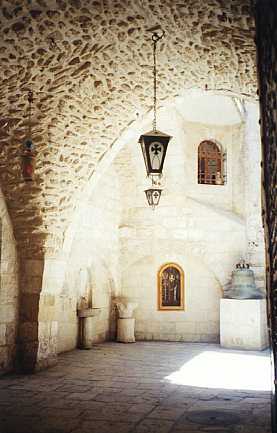 The Order de Sion is based on the Jerusalem Temple. The temple there
is called Notre Dame de Sion, named after Mary Magdalene.
The Order de Sion is based on the Jerusalem Temple. The temple there
is called Notre Dame de Sion, named after Mary Magdalene.
To the south of Jerusalem looms the 'high hill' of Mount Sion. By 1099 an abbey had been built on the ruins of an old Byzantine basilica at the express command of Godfroi de Buoillon. According to one chronicler, writing in 1172, it was extremely well fortified, with its own walls, towers and battlements. And this structure was called the Abbey of Notre Dame du Mont de Sion.
One foundation story claimed that the Templars’ founder, Hugues de Payens, encountered a Johannite “Order of the East” that retained Jesus teachings-presumably because he took them from his teacher, the Baptist, but ultimately deriving from the mystery schools of Egypt- passed on to his disciple John the Evangelist. Of course this is basically the same as the Priory’s story, except that in theirs Godefroy de Bouillon takes the place of Hugues de Payens.
Although this is very interesting, unfortunately it is impossible follow up. No one knows the origins of the Order of the Temple's story - usually it is assumed that the founder simply made it although at the very least they seem to have woven earlier traditions gether into a coherent narrative. However, the Priory’s second foundation myth is more revealing.
By 19 July 1116, the name of the Ordre de Sion was already appearing on
official charters and documents. We (LBL) found another charter, dated 1152 and
bearing the seal of King Louis VII of France, which conferred upon the Order it
first major seat in Europe, at Orleans. We found a later charter, dated 1178 and
bearing the seal of Pope Alexander III, which confirmed certain land holdings of
the Order not only in the Holy Land, but in France, Spain and throughout the
Italian peninsula - in Sicily, in Naples, in Calabria, In Lombardy.
Baigent, Leigh & Lincoln, The Messianic Legacy
Near the end of the thirteenth Century a separate detachment of
Templars was sent from the Aragonese province of Rossillon to the Rennes-le-Château
area in southern France [the old Cathar stronghold]. This fresh detachment
established itself on the summit of the mountain of Bezu, erecting a lookout
post and a chapel. Alone of all the Templars in France, they were left unmolested
by Philippe le Bel's seneschals on October 13, 1307. On that fateful day the
commander of the Templar contingent at Bezu was a Seigneur de Goth. And before
taking the name of Pope Clement V, the archbishop of Bordeaux - King Philippe's vacillating
pawn - was Bertrand de Goth. Moreover, the new pontiff's mother was Ida de
Blanchefort, of the same family as Bertrand de Blanchefort [the fourth Grand
Master of the Order of the Temple]. Was the pope then privy to some secret
entrusted to the custody of his family?
Baigent, Leigh & Lincoln, Holy Blood
Holy Grail
In documents dating from 1619, it [the Order of Sion] was stated to
have incurred the displeasure of King Louis XIII of France, who evicted them
from their seat at Orleans and turned the premises over to the Jesuits. After
that, the Prieure de Sion [the Order of Sion] seemed to vanish from the
historical record, at least under that name, until 1956, when it appeared again,
registered in the French Journal officiel.
Baigent, Leigh & Lincoln, The Messianic Legacy
According to the Priory of Sion’s original story, between 1188 and beginning of the fourteenth century, it was known as the Ormus, which is what it called itself exclusively for its first public appearance in 1962. The society was said to have come into being as a result of the mysterious cutting of the elm (orme) ritual at Gisors in 1188. They also said the Rosicrucians emerged from the higher grades of the Ormus.
The name Ormus was actually taken from the lore and tradition an earlier society, the Rite of Memphis, one of the Egyptian Rites Freemasonry. (Some commentators believe that Ormus is a form of name of the Zoroastrian creator-god Ohrmazd, a later version of Ahura Mazda. Perhaps it was originally, but in these traditions the name became associated with Egypt rather than Persia.)
The first of the Egyptian rites was the Rite of Misrairn (Hebrew “Egyptians”), created in Italy in the 1780s before spreading to Egypt and then being taken to France in 1813 by the three Bédarride brothers (Joseph, Marc, and Michel). However, as it was denounced by the Grand Orient as a danger to state security, attracting the unwanted attention the police, it wound itself up in January 1823, and most of its leaders joined Scottish Rite Freemasonry. After keeping a low profile for a few years started up again in the early 1830s.
The Rite of Memphis was originally a lodge within Misraim, having been established in Montauban in 1815 by Freemasons who had previously belonged to the French Mission to Egypt and who claimed to have been initiated into a Coptic Rosicrucian tradition in Cairo. (This is probably true, except that the society they were initiated into seems to have been a recent import from Italy.) One of this hand was Gabriel Mathieu Marconis de Negre-from the same family as the last Dame of Rennes-le-Château-who was elected Grand Master of the Rite of Misraim in 1816.
However, the Rite of Memphis was established as a separate system in 1838 or ‘39 by Gabriel’s son, Jacques Etienne Marconis de Negre, after he had been expelled twice from Misraim (once under the name Marconis and once as de Nègre). He gave the Rite its own structure, exporting it to the United States and elsewhere. (Inevitably, being so similar, the two Rites were later united into the single Rite of Memphis-Misraim, the main figure behind this being no less than the hero of Italian unification, Giuseppe Garibaldi. The rites had, and still have, a large following in Italy. In 1908 Papus became the Grand Master of Memphis-Misraim in France, a position he held until his death eight years later.)
Jacques-Etienne Marconis de Nègre associated his order with the Philadelphes of Narbonne, created by the Marquis de Chefdebien d’Armissan, which was in turn very closely connected to - basically an offshoot of the ubiquitous Rectified Scottish Rite Freemasonry.
Not unexpectedly, Marconis de Negre presented an elaborate foundation myth for his society, probably to be understood only as a metaphorical description of its esoteric, spiritual, and philosophical streams of thought. According to de Negre, the movement began with an Egyptian priest of Serapis (a later Hellenistic repackaging of the dying -and-rising god Osiris) named Ormus, who was converted to Christianity by the apostle Mark and founded the Brothers of Ormus to perpetuate this hybrid form of the Egyptian mysteries and Christianity. Soon afterward, a third stream, a Jewish school of ”Solomonic science,” formed from various sects, including the Essenes, joined the Brothers of Ormus. The Brothers of Ormus were also known as the Rosicrucians of the East (Rose-Croix d’Orient), so Ormus and Rosicrucians are linked - just as in the Priory of Sion’s version. The secret Brotherhood continued in the Middle East until the time of the Crusades, when its priests were encountered by the leaders of the Templars, who took doctrines back to Europe: this was the secret “heresy” of the Templars. It was from this stream that the Rite of Memphis claimed descent.
Of course this is essentially the same scenario as in the Priory's Church of John foundation story (and the revived Order of the Temple “Johannites of the East”), although the details are a little different. In Memphis version there is no overt Johannitism, and in the Priory version Godefroy de Bouillon takes the role of all the Templar leaders.
According to The Ritual of the A. & A. Egyptian Rite of Memphis in the I880s, the eighteenth degree of the Rite of Memphis, or “Rose Cross,” “was founded in 1188, in Palestine by the Egyptian Priest Comesius, who had been converted to Christianity,” making another parallel with Priory lore. Although the details are different-it takes place in the Middle East, not northern France. Certain major associations are present. Key concepts in the Priory’s mythos - link between Ormus, the Rosicrucians, and the year 1188 - were there in “traditions” of the Rite of Memphis long before the Dossiers Secrets. However, the Ormus tale was not even original to Marconis de Neg who borrowed it from the German Order of the Gold and Rose Cross. (Gold and Rosenkreutz)
Interestingly, while rejecting allegations that the Priory of Sion is a Masonic
system or is affiliated with the Freemasons, Gino Sandri knowledges that in the
eighteenth and nineteenth centuries the Priory was behind the creation of certain
forms of Freemasonry that were to act as its “exterior circle” (although he says
the Priory later cast them loose to follow their own paths), specifically naming
the Rite of Memphis. Sandri explains that the Priory created Memphis and, by
implication, the other orders connected with it, as fronts. But in fact the
Priory borrowed the myth of Ormus from Memphis, not the other way round. The
evidence strongly suggests that Sandri’s whole statement is also a reversal:
these Orders created the Priory as a front.
The Sion Revelation - Lynn Picknett Clive Prince
"Godfroi was, by legend, a member of the Grail Family, and by
lineage a Merovingian and apparently, rightful King of Jerusalem by his descent
from David. It is clear that he was aware of this. When he left for the first
crusade, he sold all of his property. He intended to stay in Jerusalem.
Godfroi was close to de Payen and the count of Champagne, and Baudoin [his
brother] was integral to the founding of the Templars."
J.J. Collins, "Sangraal, The Mystery of the Holy Grail"
It has been alleged that Hughes de Payens, first Grand Master of the Knights Templar, had been inducted into the Johannites, a sect which chose John the Baptist as their prophet. According to the Dossiers Secrets, each of the alleged Grand Masters of the Prieure de Sion took the name Jean in succession (supposedly influencing the name chosen by Pope John XXIII). One of the Grand Masters on the list, Leonardo da Vinci, displayed a strong interest in John the Baptist. Another, Sir Isaac Newton, became preoccupied with the writings of the Apocalypse, then attributed to John the Evangelist.
What intrigues us most is that these writings are attributed to being that of 'the disciple that Jesus loved'. Is this disciple actually Mary Magdalene? We explain this in our Jesus series.
As the Magdalene story goes; After the destruction of the Jerusalem Temple in 70A.D., there were Nazarene priests that fled to Greece and from there they scattered throughout Europe. We have two directions of travel, at the least when we are dealing with the Merovingians. One up through the Danube route, to Switzerland, to the Rhineland, to Flanders. The other, across the Mediterranean, to Southern France.
Mary Magdelene's tomb is indeed in France and we cover that in our 'Jesus' series.
Hughes de Payens, also from Champagne, was a member of a cadet branch of the Counts of Troyes.
To elaborate on this; They themselves claimed descent from Noah whom they regarded, even more than Moses, as the source of all biblical wisdom—an interesting position, which surfaced again thousands years later in European Freemasonry. The Merovingians also claimed direct descent from ancient Troy — which, whether true or not, would serve to explain the occurrence in France of Trojan names like Troyes and Paris. More contemporary writers—including the authors of the Prieurd documents’ ‘— have endeavored to trace the Merovingians to ancient Greece, and specifically to the region known as Arcadia. According to these documents the ancestors the Merovingians were connected with Arcadia’s royal house. At some unspecified date toward the advent of the Christian era they supposedly migrated up the Danube, then up the Rhine, and established themselves in what is now western Germany.
Whether the Merovingians derived ultimately from Troy or from Arcadia would now seem to be academic, and there is not necessily a conflict between the two claims. According to Homer a substantial contingent of Arcadians was present at the siege of Troy. According to early Greek histories Troy was in fact founded settlers from Arcadia. It is also worth noting in passing that the bear, in ancient Arcadia, was a sacred animal—a totem on mystery cults were based and to which ritual sacrifice was made Indeed, the very name Arcadia derives from “Arkades,” which means “People of the Bear.” The ancient Arcadians claimed descent from Arkades, the patron deity of the land, whose name means “bear.” According to Greek myth, Arkas was the son Callisto, a nymph connected with Artemis the huntress. To the modern mind Callisto is most familiar as the constellation Ursa Major—the Great Bear.
For the Sicambrian Franks, from whom the Merovingians issued, the bear enjoyed a similar exalted status. Like the ancient Arcadians they worshiped the bear in the form of Artemis—or, more specifically, the form of her Gallic equivalent, Arduina, patron goddess the Ardennes. The mystery cult of Arduina persisted well into Middle Ages, one center of it being the town of Lunéville, not far from two other sites recurring repeatedly in our investigation—Sten and Orval. As late as 1304 statutes were still being promulgated the Church forbidding worship of the heathen goddess.
Given the magical, mythic, and totemic status of the bear in
Merovingian heartland of the Ardennes, it is not surprising that
name “Ursus”—Latin for “bear”—should be associated in 'Prieure documents" with the
Merovingian royal line.
Lincoln, Baigent and Leigh
Holy Blood Holy Grail pb p238
The Merovingian dynasty issued from the Sicambrians, a tribe of the German people collectively known as the Franks. Between the fifth and seventh centuries the Merovingians ruled large parts of what are now France and Germany. The period of their ascendancy coinsides with the period of King Author - a period that constitutes the setting for the romances of the Holy Grail. It is probabably the most impenetrable period of what are now called the Dark Ages. Holy Blood Holy Grail
Further investigation produced the Merovee who was a chieftian, alive in
417, who fought under the Romans and died in 438. It has been suggested by at
least one modern expert on the period that this Merovee actually visited Rome
and caused something of a sensation. There is certainly a record of a visit by
an imposing Frankish leader conspicious for his flowing yellow hair. In 448 the
son of this first Merovee, bearing the same name as his father, was proclaimed
king of the Franks at Tournai and reigned until his death ten years later. He
may have been the first official king of the Franks as a united people. By virtue
of this, perhaps, or of whatever was symbolized by his fabulous dual birth,
the dynasty that suceeded him has since been called Merovingian.
Lincoln, Baigent and Leigh Holy Blood Holy Grail p240
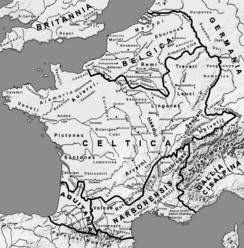 Gaul (Latin ) Gallia, Greek - Galatia ) was the region
of Western Europe occupied by present-day northern Italy. France, Belgium, western Switzerland
and the parts of the Netherlands and Germany on the west bank of the Rhine river.
Gaul (Latin ) Gallia, Greek - Galatia ) was the region
of Western Europe occupied by present-day northern Italy. France, Belgium, western Switzerland
and the parts of the Netherlands and Germany on the west bank of the Rhine river.
In Wolfram's Perceval the Priory of Sion has been traced to Valais in Switzerland. The modern name of Sidonensis, capitol of Valais is Sion. The area is located on the shores of Lake Leman to the east of Geneva. Lancelot, Galahad, Perceval and King Authur (595-603) appear on the genology chart in Lawrence Gardner's The Magdalene Legacy pg 340. King Authur's distant relative was Joseph of Arimathea (1AD - 82).
At a later date, in Visigothic times, (268) these two segments met and intermarried, thereby producing the correct conditions for a manifestation of the Living One. These things, at one time, took centuries to effect. The Visigoths were one of two main branches of the Goths, an East Germanic tribe (the Ostrogoths being the other). Together these tribes were among the loosely-termed Germanic peoples who disturbed the late Roman Empire during the Migration Period, the Visigoths adopted Arianism, a branch of Christianity that believed that Jesus was not an aspect of God in the Trinity, but a separate being created directly beneath God. This belief was in opposition to the tenets of mainstream Catholicism which achieved a religious monopoly in the 4th and 5th century.
Eighteen centuries later Godfroi emerges as the descendent that is to rule Jerusalem.. That is why the near fanatical zeal, when we see the lengths the Order has gone to protect the Grail Family, a family whose roots antedate Abraham even. The meeting up of the Ophite tradition with the Family is harder to track. Maybe in the Crusades, maybe later. Probably not earlier, unless we include Dositheos,(follower of John the Baptist) which would be proper.
The Ophites is a blanket term for numerous gnostic sects in Syria and Egypt about 100 A.D. The common trait was that these sects would give great importance to the serpent of the biblical tale of Adam and Eve, connecting the Tree of Knowledge (of Good and Evil) to gnosis. In contrast to Christian interpretations of the Serpent as Satan, Ophites viewed the serpent as the hero, and regarded the figure that the Bible identifies as God instead as being the evil demiurge. Christians supporting the church orthodoxy viewed Gnosticism as their arch enemy, and took particular offence at the Ophites turning their view of the serpent on its head, eventually persecuting them out of existence. We discuss this at length as taken from the origional Torah and the 5000 year old Enuma Elish Tablets on Forbidden Forward
It is said, the family members
had returned to the site of the 'burial' place of Christ
and gathered the remains of the most holy one and escaped
once more back to Greece. When Holy Blood Holy Grail
discusses Debussy and the Rose-Croix, they find information
on a close friend named Josephin Peladan. This Pelidan visited
the Holy Land in 1889. When he returned he claimed he had
discovered Jesus' tomb - not at the traditional site of the
Holy Sepulchre but under the Mosque of Omar, formerly part of
the Templars' enclave. In the words of an enthusiastic admirer of
Peladan's alleged discovery was "so astonishing that at any other
era it would have shaken the catholic world to its foundation.
Neither Peladan nor his associates, however, volunteered any
indication of how Jesus' tomb could have been so definitively
identified and verified as such, or why its discovery should
necessarily shake the Catholic world, unless, of cource, it
contained something significant, controversial, perhaps even
explosive. In any case Peladan did not elaborate on his discovery.
Lincoln, Baigent, and Leigh Holy Blood Holy Grail - p155
The Mystery of Rennes le Chateau
In 1891 a priest named Sauniere
undertook a modest restoration of the church. He removed a stone
alter which rested on two archaic Visigoth columns.
One of the columns was hallow. Inside it he found four
parchments preserved in sealed wooden tubes. Two of these
parchments are said to have comprised genealogies, one dating
from 1244, the other from 1644. The two remaining documents
were composed around 1780 by one of Sauniere's predecessors as
cure of Rennes-le-Chateau, the Abbe Antoine Bigou. During
his tenure in the village Bigou had also been personal chaplin
to the noble Blanchefort family, who, on the eve of the French
Revolution, were still amoung the most prominent local
landowners. One parchment has never been deciphered except
for a few lines, one of which reads, "( To Dogobert II
King and to Sion belongs this Treasure and he is there dead. )
They do not know who 'he' is.
Baigent, Leigh and
Lincoln, Holy Blood, Holy Grail
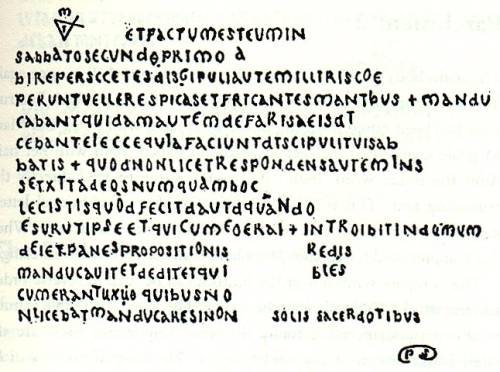 Parchment 1
Parchment 1This parchment contains a code. The code breaker is the tiny triangle at the top. The triangle of course has three sides. If it is then drawn on the parchment on a larger scale we connect it at four letters beginning with the + in the forth line and ending with the third N in the bottom line.. This spelled from top to bottom is S I O N. The key word on the parchment is 'Sion'. see pages 29-30 The Holy Place by Henry Lincoln. Lincoln did not try to decipher the second parchment. But he was sent a cipher from de Sade. The message read as follows; Shepherdess no temptation that Poussin Tenniers hold the key peace68i by the cross and this house of God I complete (or destroy) this daemon guardian at midday blue apples.
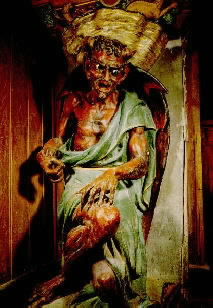 If we break this up we have; Shepherdess - NO temptation - Poussin/Tenniers
- peace 68i or 1 is very curious but ignored.
One author says this is the date of Dagobert II's death but we find it in
most books as 679. By the cross - this house of
God I complete - the daemon guardian - and midday blue apples. 'Blue apples' is
a reference to the stained glass window in the church. So each of the latter words
is a seperate clue and is probably found within the church. The Shepherdess's
forehead is the center of the pentagon that Henry Lincoln finds when he has the
painting x-rayed. This pentagon is 15 miles in circumference. The French "Zero'
meridian also falls within this pentagon. see
Parchment 2
If we break this up we have; Shepherdess - NO temptation - Poussin/Tenniers
- peace 68i or 1 is very curious but ignored.
One author says this is the date of Dagobert II's death but we find it in
most books as 679. By the cross - this house of
God I complete - the daemon guardian - and midday blue apples. 'Blue apples' is
a reference to the stained glass window in the church. So each of the latter words
is a seperate clue and is probably found within the church. The Shepherdess's
forehead is the center of the pentagon that Henry Lincoln finds when he has the
painting x-rayed. This pentagon is 15 miles in circumference. The French "Zero'
meridian also falls within this pentagon. see
Parchment 2
As the story continues, Sauniere suddenly becomes rich. He made trips to Paris and bought copies of paintings, one of which is the famous "Les Bergers d'Arcadie" - "The Shepherds of Arcadia", by Nicolas Poussin, seen here below. This tomb appears to be a virtual replica of one not too dissimilar to it right outside of Rennes-le-Château. Saunière's church indeed contains a 'daemon guardian' which is a representation of the Biblical Asmodeus, who helped King Solomon build his Temple; and some say the rays of the sun at midday passing through the stained glass window in the church create an optical effect they call 'blue apples'.
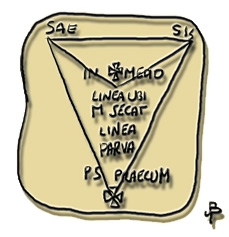
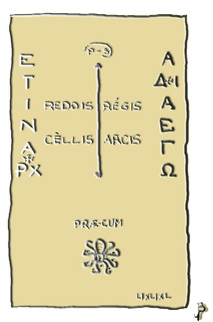 He resumed his restoration of the church and had many influential
friends. He found a crypt, skeletons, and headstones
with bizare writings on them which he destroyed. He spent
many nights digging in the courtyard beside the church and
made numberous trips over the country side. He spent lavishly
on the parishioners with banquets and other forms of largess.
He built a tower dedicated to Mary Madgalene.
Sauniere died never revealed the 'secret' he found.
He resumed his restoration of the church and had many influential
friends. He found a crypt, skeletons, and headstones
with bizare writings on them which he destroyed. He spent
many nights digging in the courtyard beside the church and
made numberous trips over the country side. He spent lavishly
on the parishioners with banquets and other forms of largess.
He built a tower dedicated to Mary Madgalene.
Sauniere died never revealed the 'secret' he found.
In the book The Sion Revelation by Lynn Picknett and Clive Prince we also find this, page 188; At the end of 1916, a great decision was taken by the 'cure of Rennes; he would preach "a new religion" and "undertake a crusade in the departement". He dismissed the representative of the Priory of Sion who came to visit him. He said he would receive no other orders than those of Jean XXIII, the last Merovingian descendent. He began to assemble 8 million francs-or (gold francs-equal to 10 francs) in banknotes. Panic reigned in the Bishopric of Carcassonne, while the prelates in the Vatican were disturbed by this situation. The Priory of Sion welcomed the affair coldly, and political circles judged this undisirable maneuver as outright war.
On his death bed, we are told, "the priest asked for Jean XXIII the Merovingian to come to him. But he would not go." This Jean XXIII was Jean Plantard - the cousin of Pierre Plantard's father. The final table is genuinely that of Plantard's family from the second half of the eighteenth century-but there is a conspicious leap after the previous one, which ends about a hundred years before.
According to one account, Sauniere made his discovery in the Visigoth pillar in Feburary 1891, after a visit of two Priory men. One account says he erased the inscription on Marie de Negre's grave (seen above left) after a visit to Paris in 1891, but it was still there 14 years later.
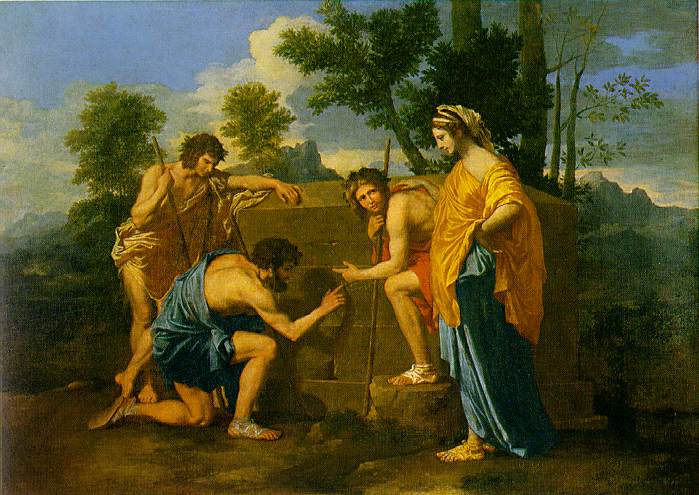 The Templar treasure and other secrets were later thought to be concealed
near Rennes le Chateau in southern France, a site where the
order was quite active. The Church at Rennes le Chateau was dedicated to Mary Magdalene,
who settled in southern France after leaving the Holy Land.
Real player pictures
click on English and then church, or many other subjects about
the Church and its history. In the painting on the right by Poussin, there is
a tombstone.
The Templar treasure and other secrets were later thought to be concealed
near Rennes le Chateau in southern France, a site where the
order was quite active. The Church at Rennes le Chateau was dedicated to Mary Magdalene,
who settled in southern France after leaving the Holy Land.
Real player pictures
click on English and then church, or many other subjects about
the Church and its history. In the painting on the right by Poussin, there is
a tombstone.
Henry Lincoln found this stone during the research for the book Holy Blood Holy Grail. However the owner of the land, Louis Lawrence had had enough of treasure hunters. When Henry visited the site in 1971 for the filming of a documentary apparently that was the last straw. The owner first blew it up with explosives and finished that off with a sledge hammer. Subsequent research of records revealed that two women had been buried there, relatives of Lawrence in the 1920's. The surprise came when the owner said that he had opened it and it was empty. It is not disclosed as 'empty' either before or after he buried the women, but we assume before because the women are still there.
An Amazing Geometry
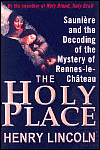
 The Shepherds of Arcadia", by Nicolas Poussin; Art expert Prof. Christopher Cornford,
of the Royal College of Art, analyzed the painting and found a complex underlying
geometry based on the pentagon.
Andrews and Schellenberger The Tomb of God were able to draw an
equilateral triangle between a symbol and key characters on Parchment 1. In
addition, they constructed a square tilted at 75 degrees on Parchment 2 which
contained the triangle on the first parchment. These two shapes can be
superimposed on a map of the Rennes-le-Château area using the Paris Zero
Meridian, appear to make a remarkable alignment with key chateaus and churches
and towns. This triangular shape from parchment 1 falls on the Coume-Sourde Stone. Andrews and
Paul Schellenbergere were also able to discern the same
geometric shapes in the three paintings above as well as several related
paintings. Henry Lincoln's Book, The Holy Place reveals explicit drawings
of the geometric positioning of the whole area, which he claims is a temple.
The Shepherds of Arcadia", by Nicolas Poussin; Art expert Prof. Christopher Cornford,
of the Royal College of Art, analyzed the painting and found a complex underlying
geometry based on the pentagon.
Andrews and Schellenberger The Tomb of God were able to draw an
equilateral triangle between a symbol and key characters on Parchment 1. In
addition, they constructed a square tilted at 75 degrees on Parchment 2 which
contained the triangle on the first parchment. These two shapes can be
superimposed on a map of the Rennes-le-Château area using the Paris Zero
Meridian, appear to make a remarkable alignment with key chateaus and churches
and towns. This triangular shape from parchment 1 falls on the Coume-Sourde Stone. Andrews and
Paul Schellenbergere were also able to discern the same
geometric shapes in the three paintings above as well as several related
paintings. Henry Lincoln's Book, The Holy Place reveals explicit drawings
of the geometric positioning of the whole area, which he claims is a temple.
The castles of Templar Château of Bezu, the Château of Blanchefort and Rennes-le-Château are each located on a mountain top. Together, with the high spots of two other peaks, the locations form a perfect pentagon (five equal sides) some fifteen miles in circumference.
In The Tomb of God, authors Richard Andrews and Paul Schellenberger have drawn their own controversial conclusion as to what the secret might have been: The bearings of the site, based on the parchments, paintings and drawings of the de Negre gravestones (that reportedly had been found by Saunière), intersect on one point - a rocky outcropping on Mount Cardou, five kilometers from Rennes-le-Château. In one of the stations (VI) of the cross that Sauniere had painted, he is pointing to this crest and the words Haut Bouclier which means 'bottom of the enclosure'. One of the messages deciphered by Linclon reads; 'At the bottom of the enclosure, make a half turn towards Cardou. One is looking at the crest.' In Rennes le Chateau there is only one enclosure and that is the cemetary. On the crest rests the remains of the Castle of Blanchfort. The story says Sauniere spent many nights digging in the cemetary. see Treasures of Rennes-le-Chateau
 Henry Lincoln, does in (The Holy Place), further research. He shows us how
the 5 mountains in the area line up to form a pentagon and within that - a 5 pointed star.
This is not the only anomoly. Several other towns, stones and rivers are all in some
sort of geometric pattern. When Sauniere took the parchments to Paris to have them
deciphered, he also obtained copies of the paintings, The Shepherds of Arcadia and
The Temptation of St. Anthony the Hermit by Teniers. These, the parchment declared,
'held the 'Key'. Gerald de Sede, author of Le Tresor Maudit (The Accursed Treasure)
clearly explained to Lincoln that it would take this latter painting to discover the
secret. Lincoln did not get a copy of this painting to use
in his research, explaining that the origional was lost and he wasn't sure which
Teniers painted the 'Temptation of St Anthony', or which version to look at.
However if the cipher read NO Temptation, this would be the correct painting (shown
here) because it is the only painting in which Anthony is not tempted.
We did a google search and infact found several renditions including the one
seen here.
And there is this one, Temptation after 1640.
And Temptation also after 1640.
Another one by the junior Teniers is located at
St Anthony - 1610-1690.
Henry Lincoln, does in (The Holy Place), further research. He shows us how
the 5 mountains in the area line up to form a pentagon and within that - a 5 pointed star.
This is not the only anomoly. Several other towns, stones and rivers are all in some
sort of geometric pattern. When Sauniere took the parchments to Paris to have them
deciphered, he also obtained copies of the paintings, The Shepherds of Arcadia and
The Temptation of St. Anthony the Hermit by Teniers. These, the parchment declared,
'held the 'Key'. Gerald de Sede, author of Le Tresor Maudit (The Accursed Treasure)
clearly explained to Lincoln that it would take this latter painting to discover the
secret. Lincoln did not get a copy of this painting to use
in his research, explaining that the origional was lost and he wasn't sure which
Teniers painted the 'Temptation of St Anthony', or which version to look at.
However if the cipher read NO Temptation, this would be the correct painting (shown
here) because it is the only painting in which Anthony is not tempted.
We did a google search and infact found several renditions including the one
seen here.
And there is this one, Temptation after 1640.
And Temptation also after 1640.
Another one by the junior Teniers is located at
St Anthony - 1610-1690.
Lincoln got permission to have the Shepherds of Arcadia X-rayed. This provided the Key to only half the puzzle. The Arcadia painting shows that the central point in the pentagon is the La Pique mountain. The Shepherds are placing their fingers on a point we believe to be the Coume-Sourde Stone, which is only a couple of hundred meters from a farm house called Coume-Sourde. The Poussin tomb stone in the Shepherds of Arcadia painting and the location of the Coume-Sourde Stone, are central to some sort of secret which we think Lincoln merely dismissed as unimportant.
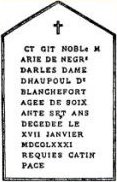 This image appears on parchment two and on a stained glass window at Rennes le Chateau.
Other clues were also dismissed; such as the decipherment of the tombstone
of Marie De Negri ( right) which reads; 'At Royal Reddis in the store-rooms of the fortress.'
The grave stone also has a monogram with a looped line around a P & S.
This image appears on parchment two and on a stained glass window at Rennes le Chateau.
Other clues were also dismissed; such as the decipherment of the tombstone
of Marie De Negri ( right) which reads; 'At Royal Reddis in the store-rooms of the fortress.'
The grave stone also has a monogram with a looped line around a P & S.
P (above left) is preceded by O and S is preceded by R making 'Or' which means gold. Sauniere destroyed the face of this grave stone so it must have been important. However the book Pierres Gravees de Languedoc by Eugene Stublien had already published the writing on the tomb stone. Another pamphlet called Excursion du 25 Juin 1905, a Rennes-le-Chateau, by E. Tisseyre was also published in 1906 with the same wording and monogram. The monogram was on parchment 1 and on the Coume Sourde-Stone (above left). Decipherment of the rest of the tombstone says; It is ET in Arcadia Ego. The word Arcaida is broken into two parts of which read; and 'in Arc'. The phrase 'Et in Arcadia Ego' translated into English has been interpreted to mean, Even in earthly paradise, I (death) exist. Lincoln doesn't dismiss this but can't explain it.
"The secret itself is the Tomb Of Jesus, in where the remains of Jesus
are (were) kept. They have checked and double checked and triple checked every new
discovered hint and answer, and they have come to the conclusion that the
different hints all point to the same location. After a search in the given
location, there are indications that a tunnel has been excavated in early middle
ages. Unfortunately, the entrance to the possible tunnel is blocked by thousands
of tons of stone and rock. Only a official extensive excavation with modern gear
will probably give an answer."
Sander van der Linden (private correspondence)We do not know where this
'location' is.
The entire piece, given in French in the end notes to Holy Blood, Holy Grail, is rather cryptic. It does not openly speak of the Merovingians. Instead, it speaks of the descendants of Benjamin, and implies the region of the Peloponnese known as Arcadia, and Poussin the painter, in some way bringing all these together.
![]() Sometime around 600AD, some say that the Templers may have
returned to the site of the destroyed temple in Jerusalem and re-buried the
bones. There were many passage ways and rooms under Herod's
Temple and on the walls of these rooms it is said there are
writings, describing the genealogy of the priests of the temple
as far back as to David and Aaron. The group took on a
destinctive name and it is this group who held the actual royal
'blood-lines' of Jesus, David, Aaron and Moses. They had
'secrets' which they were to pass
on to the chosen son of the family. They were told that the other
members could be identified by the particular genealogies they
all possessed. The group is called by some, "Rex Deus". The actual
descendents of Jesus are outlined in
Holy Blood, Holy Grail and The Magdalene Legacy.
Sometime around 600AD, some say that the Templers may have
returned to the site of the destroyed temple in Jerusalem and re-buried the
bones. There were many passage ways and rooms under Herod's
Temple and on the walls of these rooms it is said there are
writings, describing the genealogy of the priests of the temple
as far back as to David and Aaron. The group took on a
destinctive name and it is this group who held the actual royal
'blood-lines' of Jesus, David, Aaron and Moses. They had
'secrets' which they were to pass
on to the chosen son of the family. They were told that the other
members could be identified by the particular genealogies they
all possessed. The group is called by some, "Rex Deus". The actual
descendents of Jesus are outlined in
Holy Blood, Holy Grail and The Magdalene Legacy.
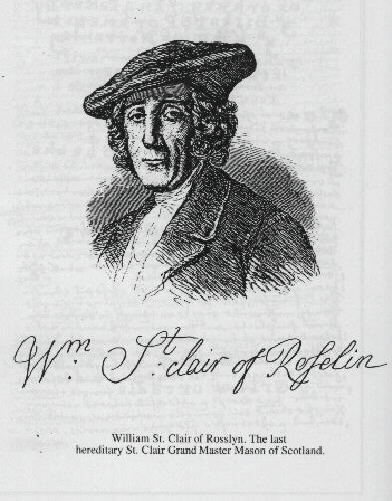 "In the case of the chalice on the tombstone of Sir
William de St. Clair at Rosslyn, the cup encloses an octagonal
rosy cross with the flower signifying
Christ's blood in the centre. It is one of the earliest
representations of that symbol, held to be part of the Gnostic
revelations or secret Gospels known to the Knights of the Order
of the Temple of Solomon [The Templars] and later to the Brother
hood of the Rosy Cross, which considered the heart of Jesus to
be the temple where the life of the world dwelt
as well as a rose and a cup. It also suggests a connection
between the Templars and the Cathars, before their destruction
in the Albigensian Crusade. The Cathars were also Gnostics, who
were much influenced by the troubadour Courst of the Langue
d'Oc, particularly by the seminal knightly romance epic, the
"Roman de la Rose", and the later Grail romances. In these, the
Templars riding with their red cross were the keepers of the
secret of the rose within the chalice. The Grail on the
St. Clair tombstone also explains why the Grail is still held
to be within the Apprentice Pillar in Rosslyn Chapel, a pillar
built especially to enclose it".
..see Grail Legends
"In the case of the chalice on the tombstone of Sir
William de St. Clair at Rosslyn, the cup encloses an octagonal
rosy cross with the flower signifying
Christ's blood in the centre. It is one of the earliest
representations of that symbol, held to be part of the Gnostic
revelations or secret Gospels known to the Knights of the Order
of the Temple of Solomon [The Templars] and later to the Brother
hood of the Rosy Cross, which considered the heart of Jesus to
be the temple where the life of the world dwelt
as well as a rose and a cup. It also suggests a connection
between the Templars and the Cathars, before their destruction
in the Albigensian Crusade. The Cathars were also Gnostics, who
were much influenced by the troubadour Courst of the Langue
d'Oc, particularly by the seminal knightly romance epic, the
"Roman de la Rose", and the later Grail romances. In these, the
Templars riding with their red cross were the keepers of the
secret of the rose within the chalice. The Grail on the
St. Clair tombstone also explains why the Grail is still held
to be within the Apprentice Pillar in Rosslyn Chapel, a pillar
built especially to enclose it".
..see Grail Legends
Continued on Knights 2 - The Crusades and more
Where did the ancient knowledge begin? See for yourself on Forbidden Knowledge
Why are Egyptian religious beliefs connected with Masonry?..
see for yourself on
The Secret of the Great Pyramid of Gaza
Go to the First page of this site.. Hiram Abiff, King of Egypt, 1554 B.C.
These pages are a new series explaining the relationship of the Mason's to Egypt and Egyptian religion.
This site has a third page, which covers, Oklahoma sites including the Oklahoma Indian Degree Team, our Order of Eastern Star and other Oklahoma links. PAGE 3
This guest book is set to not allow postings to be displayed until reviewed. Not because of negative comments but because a bored young lady filled in 4 or more comment sections and thought it was cute. We don't delete negative comments unless they contain profanity or they contain comments that call Masons devil worshipers ect., which we catagorize as a religious debate and is unexceptable. If you care to read the forbidden forward page, you will see real secrets revealed.
View My Guestbook
 Sign My Guestbook
Sign My GuestbookSearch this site
Our search Engine does not search for the links in this site, only words in the text.
NO PART OF THIS SITE MAY BE COPIED OR REPRODUCED, IN WHOLE OR IN PART WITHOUT THE EXPRESS WRITTEN APPROVAL OF THE WEBMASTER. © COPYRIGHT 1999 - 2009 C.I.Case...ALL RIGHTS RESERVED.
If your site is not Masonic in nature, We kindly ask that you do
not link to this site without permission of the Web Master under the guidelines set forth here...
Legal Issues
This site has been visited... Times since November 30th, 1999
"Great spirits have always encountered violent opposition from mediocre minds" -- Albert Einstein
"I may not agree with what you have to say, but I shall defend to the death your right to say it!" Quote from Sir Lancelot